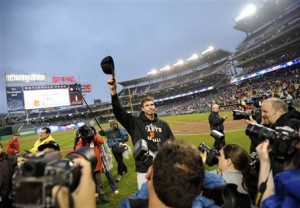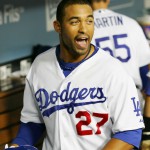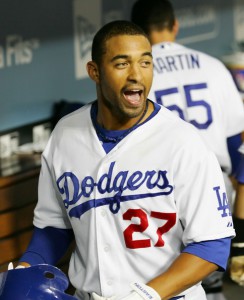
San Francisco Giants starter Randy Johnson acknowledges the crowd after the Giants beat the Washington Nationals 5-1 for his 300th win, in the first game of a baseball doubleheader Thursday, June 4, 2009, in Washington. (AP Photo/Nick Wass)
Despite being much maligned as a method of judging a starting pitcher’s worth, the “Win” is still the essential goal of every starter in the majors and the accumulation of them over a season or career still inspires much thought and discussion. The magical “300 win” threshold remains one of the more challenging career objectives for any starter, and remains an interesting benchmark to discuss. Only 23 pitchers in the history of the game have reached 300 wins.
So, after Randy Johnson‘s reaching the benchmark, and after a number of recent start pitchers also hitting the plateau (Greg Maddux, Roger Clemens and Tom Glavine), are we ever going to see another 300-win pitcher?
Here’s some other reading on this same topic by the likes of John Dewan (referencing Bill James‘ annual predictions on who may reach 300 wins with his percentile chances), David Schoenfield (in a dated piece predicting Roy Halladay‘s chances for getting to 300 wins), and an early 2012 piece from Jon Paul Morosi talking about Clayton Kershaw‘s chances.
Achieving 300 wins in a career is getting more and more difficult. Here’s some interesting stats about reaching 300 wins for a starter in the modern baseball age:
- If a pitcher were to enter the major leagues at age 23, he would need to AVERAGE 20 wins for the next 15 years to reach 300 and pitch until age 38.
- Put another way, that same pitcher entering at age 23 would have to average 18 wins for 17 seasons to reach 300 by about age 40.
- The majors have had ONLY Eleven 20-game winners in total over the past 5 seasons. (Seven of which have come in the last two years, echoing the “rise of the pitcher” and the collapse of the PED slugger era, so perhaps its getting easier to accumulate wins).
- 5-man rotations mean that starters are averaging 33-34 starts a year, down from the 38-40 starts that Pitchers would get just 20 years ago.
- Because of mania over inning counts, specialized relievers, and an obsession with using “closers” in save situations, starters now only earn decisions in around 69% of starts, down from 78.5% of starts in 1972 (source Jay Jaffe‘s article, referenced further down). This means the average pitcher only gets about 24 decisions from their 33-34 starts, making the 20-game winner even that more rare. One can argue that better pitchers get more decisions because they’re more likely to pitch into the 7th and 8th innings, by which time their team should have scored enough runs to win for them. But the fact remains that a lot of wins and losses are in the modern bullpen.
In 2009, just as Randy Johnson won his 300th, I had two long winded discussions (one in April 2009, another in June 2009) an older version of this blog that I maintained with friends about the demise of the 300-game winner. Blog author Jason Amos did a great summary in this posting along with some great links. Now, with another 3 seasons in the books, I thought it might be interesting to see who we were considering as candidates just a few years ago and who might be the next “best” candidates to get to 300 wins. I’ll address candidates and their chances as we present pitchers a number of different ways.
(coincidentally, the 300-game winner spreadsheet I’m using for this post can be found at this link, and in the Links section along the right hand side of this page).
Here’s the current list of active wins leaders post 2012. For brevity’s sake here’s the top 10 (and I’ve included Jamie Moyer as being “active” for the sake of this argument):
| Rank |
pitcher |
age |
wins |
| 1 |
Jamie Moyer |
49 |
269 |
| 2 |
Andy Pettitte |
40 |
245 |
| 3 |
Roy Halladay |
35 |
199 |
| 4 |
CC Sabathia |
31 |
197 |
| 5 |
Tim Hudson |
36 |
197 |
| 6 |
Livan Hernandez |
37 |
178 |
| 7 |
Derek Lowe |
39 |
175 |
| 8 |
Mark Buehrle |
33 |
174 |
| 9 |
Bartolo Colon |
39 |
171 |
| 10 |
Kevin Millwood |
37 |
169 |
Of this list of top 10 active win leaders, clearly most of them are never going to reach 300 wins. Jamie Moyer has not yet retired at age 49, but the odds of him even making another MLB roster seem thin. Likewise Livan Hernandez and Derek Lowe may struggle to get guaranteed contracts in 2013. Andy Pettitte has returned and pitched effectively for the Yankees this year, but he’s 50+ wins away from the plateau and only seems likely to maybe pitch one more year. Bartolo Colon does have a contract for 2013 but it may be his last season, and Kevin Millwood is just too far away. Tim Hudson, despite his strong performances the last few years, is just too far away at this point as well. The chances of any of these guys to reach 300 wins is 0%.
How about the rest of this top 10 list? Specifically CC Sabathia, Roy Halladay and Mark Buehrle? There’s some intriguing candidates there. Lets look at their chances a slightly different way.
When Randy Johnson hit 300 wins, two Baseball Prospectus authors posted similar posts to this with some interesting analysis. First, Jay Jaffe used a fun little stat he called the Jaffe Blind Optimism method (JABO), which takes a pitcher and assumes he will win 15 games a year until age 42. Well, this incredibly optimistic formula leads us to a new set of more reasonable candidates. I changed the formula slightly and only ran out the 15 wins/year til age 40 and got this list:
| Rank |
pitcher |
age |
wins |
Jaffe 15wins/yr avg->40 |
| 1 |
CC Sabathia |
31 |
197 |
332 |
| 2 |
Felix Hernandez |
26 |
98 |
308 |
| 3 |
Clayton Kershaw |
24 |
61 |
301 |
| 4 |
Trevor Cahill |
24 |
53 |
293 |
| 5 |
Justin Verlander |
29 |
124 |
289 |
| 6 |
Matt Cain |
27 |
85 |
280 |
| 7 |
Mark Buehrle |
33 |
174 |
279 |
| 8 |
Yovani Gallardo |
26 |
69 |
279 |
| 9 |
Chad Billingsley |
27 |
80 |
275 |
| 10 |
Roy Halladay |
35 |
199 |
274 |
By this analysis we see that CC Sabathia looks like a pretty sure bet to hit 300 wins, and for good reason. He’s been healthy, he plays for a team that is constantly winning, and he doesn’t have to pitch like a Cy Young award winner to get wins in New York (21, 19 and 15 wins his last three seasons). He has always been healthy and just needs 5 more solid seasons to be very close to the 300 win plateau. He’s signed through 2016 (with an option for 2017), and there’s no reason to think he’s not going to see that contract through. His elbow-injury scare in the post-season turned out to be innocuous, but we’ll keep an eye on his health status in 2013. If he loses a season or more to injury the chances of his making 300 wins declines precipitously. Felix Hernandez has nearly a 100 career wins at age 26, and also seems like a decent bet to hit 300 wins at this point. But, he’ll need to move to a winning team to make this task easier on himself; he’s only won 13,14 and 13 games the last three seasons because of dreadful run support. He’s signed through 2014 and I’d be surprised if he stays in Seattle (unless they turn that franchise around in the next 3 years).
Clayton Kershaw and (surprisingly) Trevor Cahill appear here by virtue of a lot of early career success (Cahill was an 18 game winner for a bad Oakland team at age 22 in the majors, no small feat). While both have been injury free thus far, it is really difficult to project 24yr olds as staying healthy deep into their 30s. So, we’ll say they’re promising for now but need to get to about 150 wins before we can really start projecting their odds. Yovani Gallardo has quietly been racking up wins as Milwaukee’s “ace,” but is sort of in the same boat as Kershaw and Cahill; he’s only 26, so its hard to see how he’ll sit at age 30. If he’s got another 60-70 wins in four year’s time, we’ll talk.
Justin Verlander‘s 24-win season in 2011, as well as his established status as the “Best Pitcher in Baseball” right now, has launched him into the discussion. The problem is that he “only” has 124 wins entering his age-30 year. He needs to average 18 wins a year for the next decade to have a shot. That’s a tall task, especially considering how well he pitched to just get to 17-8 this year. It isn’t out of the realm of possible, but it is a longshot.
Mark Buehrle and Roy Halladay are both aging workhorses whose chances of reaching the plateau are dimming. Buehrle has just moved to the hyper-competitive AL East and wasn’t exactly dominating to begin with. Meanwhile Halladay’s injury struggles have limited his wins the last couple seasons, likely knocking any chance he had of hitting the plateau. I’ll give them each non-zero chances, but barely non-zero. I’ll give them both the benefit of the doubt because they both seem like the kind of pitchers who could pitch well into their 40s and get the extra wins they’d need to move over the top.
Matt Cain and Chad Billingsley are both mentioned because they had a ton of wins before the age of 25; both in reality are not accumulating wins at the pace they’ll need to stay even close to hitting the 300-win plateau. Plus Billingsley struggled with an injury this year and may be affected next season. Chances right now; slim.
Just for the sake of argument, here’s the next 10 players ranked by the modified Jaffe system:
| Rank |
pitcher |
age |
wins |
Jaffe 15wins/yr avg->40 |
| 11 |
Zack Greinke |
28 |
91 |
271 |
| 12 |
David Price |
26 |
61 |
271 |
| 13 |
Johnny Cueto |
26 |
60 |
270 |
| 14 |
Gio Gonzalez |
26 |
59 |
269 |
| 15 |
Carlos Zambrano |
31 |
132 |
267 |
| 16 |
Jered Weaver |
29 |
102 |
267 |
| 17 |
Jon Lester |
28 |
85 |
265 |
| 18 |
Jair Jurrjens |
26 |
53 |
263 |
| 19 |
Ervin Santana |
29 |
96 |
261 |
| 20 |
Tim Lincecum |
28 |
79 |
259 |
I posted this list because a number of these players were formerly listed as good candidates to hit 300 wins. Specifically, Carlos Zambrano, Jered Weaver, and Tim Lincecum. Zambrano may be out of baseball in 2013, Lincecum may not even be a starter any more, and Weaver, while clearly getting a ton of wins lately needs a slew of 19-20 game winning seasons to catch back up. The collection of 26-yr olds in David Price, Johnny Cueto, and our own Gio Gonzalez are all well behind the paces being set by fellow-aged pitchers Hernandez, Cain and Gallardo, though it isn’t hard to see any of these three post multiple 18-20 win seasons in the coming years.
So, here’s my predictions of the chances by player discussed above (anyone not listed here specifically also sits at 0% chance of making 300 wins):
| Name |
age |
wins |
% Chance |
| CC Sabathia |
31 |
197 |
90% |
| Felix Hernandez |
26 |
98 |
75% |
| Justin Verlander |
29 |
124 |
33% |
| Clayton Kershaw |
24 |
61 |
25% |
| Trevor Cahill |
24 |
53 |
20% |
| Roy Halladay |
35 |
199 |
10% |
| Yovani Gallardo |
26 |
69 |
10% |
| Mark Buehrle |
33 |
174 |
5% |
| Matt Cain |
27 |
85 |
5% |
| Chad Billingsley |
27 |
80 |
5% |
| Jamie Moyer |
49 |
269 |
0% |
| Andy Pettitte |
40 |
245 |
0% |
| Tim Hudson |
36 |
197 |
0% |
| Livan Hernandez |
37 |
178 |
0% |
| Derek Lowe |
39 |
175 |
0% |
| Bartolo Colon |
39 |
171 |
0% |
| Kevin Millwood |
37 |
169 |
0% |
Conclusion: I believe we will see another 300-game winner. I think Sabathia has a very good chance of making it, as does Felix Hernandez at this point in his career. But injuries can quickly turn a 300-game career into an “out of baseball by 36” career, so nothing is set in stone.


